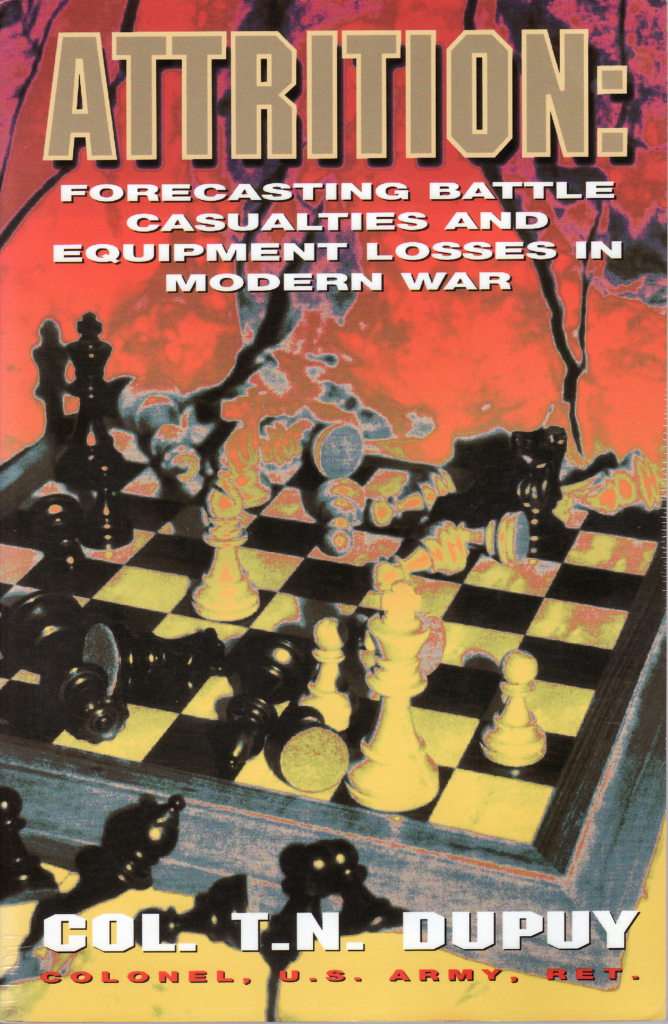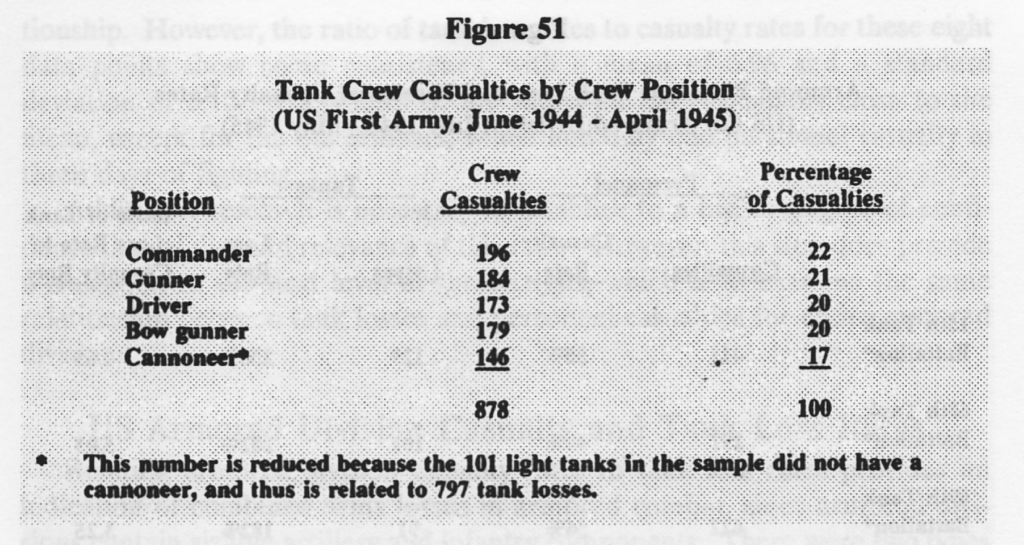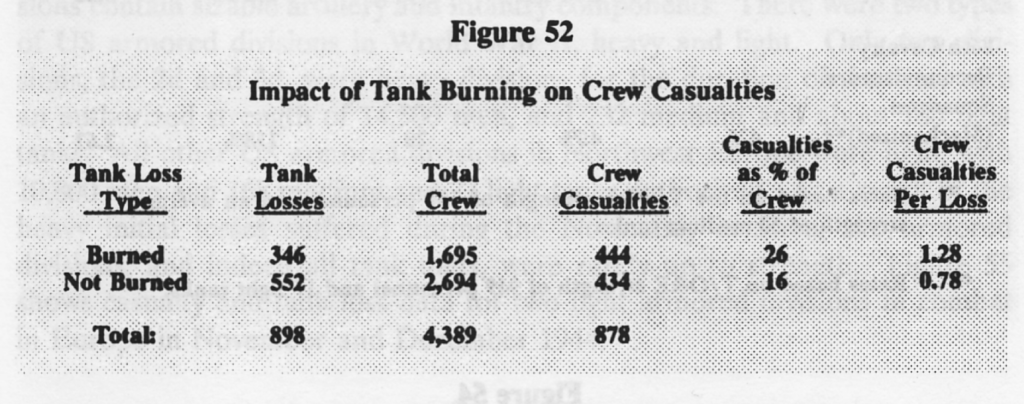 In his 1990 book Attrition: Forecasting Battle Casualties and Equipment Losses in Modern War, Trevor Dupuy took a look at the relationship between tank losses and crew casualties in the U.S. 1st Army between June 1944 and May 1945 (pp. 80-81). The data sampled included 797 medium (averaging 5 crewmen) and 101 light (averaging 4 crewmen) tanks. For each tank loss, an average of one crewman was killed or wounded. Interestingly, although gunfire accounted for the most tank and crew casualties, infantry anti-tank rockets (such as the Panzerfaust) inflicted 13% of the tank losses, but caused 21% of the crew losses.
In his 1990 book Attrition: Forecasting Battle Casualties and Equipment Losses in Modern War, Trevor Dupuy took a look at the relationship between tank losses and crew casualties in the U.S. 1st Army between June 1944 and May 1945 (pp. 80-81). The data sampled included 797 medium (averaging 5 crewmen) and 101 light (averaging 4 crewmen) tanks. For each tank loss, an average of one crewman was killed or wounded. Interestingly, although gunfire accounted for the most tank and crew casualties, infantry anti-tank rockets (such as the Panzerfaust) inflicted 13% of the tank losses, but caused 21% of the crew losses.
 Casualties were evenly distributed among the crew positions.
Casualties were evenly distributed among the crew positions.
 Whether or not a destroyed tank caught fire made a big difference for the crew. Only 40% of the tanks in the sample burned, but casualties were distributed evenly between the tanks that burned and those that did not. This was due to the higher casualty rate in the tanks that caught fire (1.28 crew casualties per tank) and those that did not (0.78 casualties per tank).
Whether or not a destroyed tank caught fire made a big difference for the crew. Only 40% of the tanks in the sample burned, but casualties were distributed evenly between the tanks that burned and those that did not. This was due to the higher casualty rate in the tanks that caught fire (1.28 crew casualties per tank) and those that did not (0.78 casualties per tank).
 Dupuy found the relationship between tank losses and casualties to be straightforward and obvious. This relationship would not be so simple when viewed at the battalion level. More on that in a future post [Tank Loss Rates in Combat: Then and Now].
Dupuy found the relationship between tank losses and casualties to be straightforward and obvious. This relationship would not be so simple when viewed at the battalion level. More on that in a future post [Tank Loss Rates in Combat: Then and Now].

Crew survivability in American tanks seemed to be higher than Soviets AFVs. I wonder how many crew members were killed after bailing out, this number would probably be significantly higher on the eastern front.
So for the Panzerfaust, does this suggest a lower accuracy (or effectivness limited to confined areas), but a higher chance for HEAT killing the crew?
What it means is that Panzerfausts hit less tanks (shots missing, not penetrating, defective, etc) however when it did penetrate it’d be highly effective as compared to other weapons.
Panzerfaust range in Normandy was either 40 or 60 meters for the two types. Used by ordinary infantry who had probably never fired one before as they were too scarce to waste on practice. Dedicated American bazooka and Commonwealth Piat teams with a range of 100 yards, had lots of practice with their weapons and thus were more accurate. The old “practice makes perfect” rule applies here. Germans did not have any practice.
Weapons equality in ww2 as in ww1 was a given and both sides knew any advancement would soon be rectified by their advisory. Allies went for numbers because the west had an advantage in production and distance from the battle field. U.S. Civil War a good example of parity in weapons and position. The Sherman Tank and the P-40 were examples of this approach, They were adequate and numbers would overcome skill and quality. And if you are willing to fight ; ADEQUATE is good enough. In close the Sherman was the best tank because of fast firing gyro gun. At a distance the German 88 would kill anything. The defenders have a 10 to 1 advantage and that is about what the Germany knock-off rate of Sherman Tanks was . American infantry foot soldier loved their Sherman because it was always there and provided excellent cover , it was tall and could take on everything but high speed German shell , the fighter bombers did that. Remember that Audie Murphy used a Sherman to get a silver Star.
True the armour piercing round of the Sherman 75mm was barely adequate compared to the higher velocity German tank guns which were superior in that respect. However the bigger explosive charge in the Sherman 75mm HE round was far superior to the smaller charge in the German tank HE round. You can’t have it both ways. Which is more important a great AP capability or a great HE capability. Depends on the mission. German tanks in Normandy and on the Russian front were employed almost solely in an anti tank role and were designed for that role. Shermans were mainly employed in an infantry support role and a breakout role where HE was deciding factor. American, Canadian and British infantry men loved the Sherman as it’s more powerful HE round could blow the crap out of German strongpoints, MG 42 positions and anything else that was not a tank, and this saved lives.
Reading Canadian armored unit war diary’s shows that the main concern of Canadian tankers was Luftwaffe 88 guns not Panthers or Mark 4s, and you use HE to knock out an anti tank gun or artillery piece. The majority of tanks knocked out are not knocked out by other tanks and where Canadian tanks encountered Panzers, usually at short ranges the results were about equal.
Terrain bestows advantages or disadvantages on one particular design. The open steppes of Russia/Ukraine were perfect for German long range sniping and the Panzers did rack up high kill ratios. The bocage the Americans fought in was claustrophobic with everything at very short ranges with limited visibility, great for panzerfausts and bazookas, not so good for tanks. All of the tank encounters and there were very few in the bocage, were ambushes and the tank doing the ambushing got the kill.
Which is better, Panther or Sherman. Depends on the particular mission or scenario.
Terry, what incident were you referring to with Audie Murphy using a Sherman to get a silver star? The only instance I’m aware of where he used armor and was awarded a medal, it was when he got the Medal of Honor for killing/ wounding 50 enemy by firing the .50 cal. on the back of a burning M10 tank destroyer. If you’re remembering that as a Sherman due to the movie, “To Hell and Back”, you have to remember that Audie Murphy himself was upset that they used a Sherman in that scene. He had a fondness for the M10 tank destroyer, which is what he’d used in real life, but evidently none were available for shooting the movie, so they substituted in a Sherman.
Not sure where you got your figures from. I know that in general defenders should have a 10 to 1 advantage – yet the kill to loss ratio of Shermans was way lower than that throughout the Allied forces and Patton’s kill to loss ratio was close to 3:1 – in other workds he was knocking out 3 enemy AFVs for every Sherman he lost.
I may have been an M=10 tank destroyer. He was also calling in artillery support and may have killed 40 Germans. Uncertain how many were killed by the artillery. But is shows that the action in the movie “FURY”, something similar could have happened. Though unlikely.
This last point is a very significant point. Most tanks in WWII carried more HE rounds than AP rounds. People have a tendency to compare tanks versus tanks, as opposed to tanks versus everything that they engage in the battlefield.
It is certainly a compelling topic, but people on the Internet believe that tanks were the most important asset in the war, while only representing a fraction of the total firepower.
Example:
For 1943 German expenditure on Tank and Anti Tank ammo (including AT guns above 50mm and turret systems PzGr, Hl and Sprg.): 25,787 tons vs 798,324 tons for field artillery alone (even excluding heavier caliber guns).
Barbarossa is also a good example, during these 6 months the ratio of AT to HE munitions used was 2,600 t Panzergranatpatronen aller Art (all sorts) vs 5,500+ tons of HE munition.
Their personnel (or crews for that matter) in relation to the total military personnel of the apparatus was also rather small. The Allies and Soviets made also larger use of AFVs than the Germans initially did.
Just a short question: The majority of literature lists totals for Allied armour losses (for various operations or fronts etc., except for the Ardennes study), do documents on day to day losses exist (and their respective categorization)?
I have not seen such a master list, but have never looked.
We assembled the daily losses for Ardennes by going the division and battalion records of the units involved. Certainly the data exists, but it would take considerable effort to assemble it.
I counted the loss of crew members T-34 tanks. Three tank regiments and six brigades, mainly in the summer-autumn 1943.
https://rostislavddd.livejournal.com/359840.html
Thanks. Very interesting. I may have to blog about this at some point.
[…] The chart below shows statistics from July 1944 until May, 1945 with high casualties and a casualty rate mostly exceeding 50 percent. […]
Statistics of the losses of the crews of the Soviet Shermans. 46th Guards Tank Brigade, December 1944 – April 1945 (Hungary, Austria, Czechoslovakia).
Full compliance with the statistics of the First Army on the Western Front.
https://rostislavddd.livejournal.com/365699.html
Rostislav. Thanks. At some point when I have a little more time, I am going to have to re-post up some of your blog posts along with translations. Good stuff !
Chance that at least one crewmember was killed in a Sherman on the WF (US 1st Army, Table XX) ~48% vis 61% on the EF.
Avg. killed per loss is 0.62 and 0.85 respectively (2.97-3.41 casualty per tank, estimated since no WIA and MIA are listed). Median daily loss rate of 2.62 per day (76 days). Mortality (based on the samples) WF: 0.125, EF: 0.17.
It is necessary to compare similar with similar. In the Red Army, the irreparable loss of servicemen – KIA and MIA. In reports and battle logs of the 46th brigade, MIA periodically appears, but I did not find a single missing person in the loss lists.
Example, the battle for Kebelkut January 6-7. According to the magazine of military operations:
Losses of the brigade:
Tanks burned – 3
Damaged – 3
In personnel:
killed: officers – 7.
privates and sergeants – 11
Injured: officers – 5
Private and sergeants – 12
Missing: officers – 2
Private and sergeants – 5
Burial diagrams are attached to the reports of irretrievable losses.In the report on losses to the rank and file of the 46 brigade in January, are shown 34 killed and only 23 buried personnel . MIA are absent.
https://vfl.ru/fotos/203db5d228089995.html
Yes and you compared Soviet KIA with US KIA+WIA+MIA. The ratio of irrecoverables changed somewhat in the later phase of the war, but it is still safe to say that most MIA on the EF were probably irretrievables, increasing the spread even further.
>Yes and you compared Soviet KIA with US KIA+WIA+MIA.
No, only KIA and MIA. 11 Soviet soldiers whose bodies were not found should in principle be shown as MIA, but Colonels Mikhno and Kornyushin did not want to create problems for them families.
P.S. Sport – shoot away a tankmen who jumped out of a burning tank was equally popular in the east and west .
I forgot to clarify. In fact, fewer “tank commanders” could die in tanks than indicated in the table.
For officers: tank commanders , tank platoons, and tank companies it’s relatively clear, but above there may be options .
December 6, 1944 – captain V.D. Tikhonov (S-3 3-46 GTBr)
January 13, 1945 – captain I.I. Yakushkin (СО 1-46 GTBr)
Senior Lieutenant Loza became battalion commander after him.
https://iremember.ru/en/memoirs/tankers/dmitriy-loza/
March 25, 1945 – Major I.V. Romanenko (СO 3-46 GTBr).
Our estimation, based upon some work done with Kursk in July 1943, is that 75% of the Soviet MIA are CIA (Captured in Action). Obviously this changes depending on which campaign they are involved in.
Update statistics on the loss of crews of the T-34 and T-70, as well as the ammunition consumption of the 186th tank brigade, from July 7 to August 22, 1943
https://rostislavddd.livejournal.com/373839.html